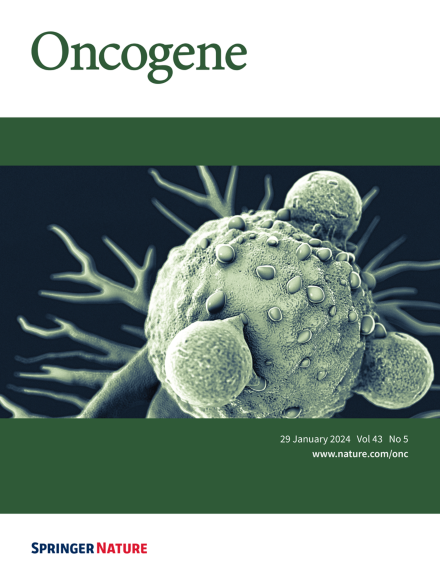Dependence of PAX3-FOXO1 chromatin occupancy on ETS1 at important disease-promoting genes exposes new targetable vulnerability in Fusion-Positive Rhabdomyosarcoma
IF 6.9
1区 医学
Q1 BIOCHEMISTRY & MOLECULAR BIOLOGY
引用次数: 0
Abstract
Rhabdomyosarcoma (RMS), a malignancy of impaired myogenic differentiation, is the most common soft tissue pediatric cancer. PAX3-FOXO1 oncofusions drive the majority of the clinically more aggressive fusion-positive rhabdomyosarcoma (FP-RMS). Recent studies have established an epigenetic basis for PAX3-FOXO1-driven oncogenic processes. However, details of PAX3-FOXO1 epigenetic mechanisms, including interactions with, and dependence on, other chromatin and transcription factors, are incompletely understood. We previously identified a novel disease-promoting epigenetic axis in RMS, involving the histone demethylase KDM3A and the ETS1 transcription factor, and demonstrated that this epigenetic axis interfaces with PAX3-FOXO1 both phenotypically and transcriptomically, including co-regulation of biological processes and genes important to FP-RMS progression. In this study, we demonstrate that KDM3A and ETS1 colocalize with PAX3-FOXO1 to enhancers of important disease-promoting genes in FP-RMS, including FGF8, IL4R, and MEST, as well as PODXL, which we define herein as a new FP-RMS-promoting gene. We show that ETS1, which is induced by both PAX3-FOXO1 and KDM3A, exists in complex with PAX3-FOXO1, and augments PAX3-FOXO1 chromatin occupancy. We further show that the PAX3-FOXO1/ETS1 complex can be disrupted by the clinically relevant small molecule inhibitor YK-4-279. YK-4-279 displaces PAX3-FOXO1 from chromatin and interferes with PAX3-FOXO1-dependent gene regulation, resulting in potent inhibition of growth and invasive properties in FP-RMS, along with downregulation of FGF8, IL4R, MEST and PODXL expression. We additionally show that, in some FP-RMS, KDM3A also increases PAX3-FOXO1 levels. Together, our studies illuminate mechanisms of action of the KDM3A/ETS1 regulatory module, and reveal novel targetable mechanisms of PAX3-FOXO1 chromatin complex regulation, in FP-RMS.

PAX3-FOXO1 染色质占位在重要疾病促进基因上对 ETS1 的依赖性揭示了融合阳性横纹肌肉瘤新的靶向脆弱性。
横纹肌肉瘤(RMS)是一种肌源性分化受损的恶性肿瘤,是最常见的儿童软组织癌症。PAX3-FOXO1融合驱动了大多数临床上更具侵袭性的融合阳性横纹肌肉瘤(FP-RMS)。最近的研究为 PAX3-FOXO1 驱动的致癌过程奠定了表观遗传学基础。然而,人们对 PAX3-FOXO1 表观遗传学机制的细节,包括与其他染色质和转录因子的相互作用和依赖性还不完全了解。我们之前在 RMS 中发现了一个新的疾病促进表观遗传轴,涉及组蛋白去甲基化酶 KDM3A 和 ETS1 转录因子,并证明了该表观遗传轴与 PAX3-FOXO1 在表型和转录组上的相互作用,包括共同调控对 FP-RMS 进展很重要的生物过程和基因。在本研究中,我们证明了 KDM3A 和 ETS1 与 PAX3-FOXO1 共同定位到 FP-RMS 中重要疾病促进基因的增强子上,包括 FGF8、IL4R 和 MEST,以及 PODXL,我们在此将其定义为新的 FP-RMS 促进基因。我们发现,ETS1 同时受到 PAX3-FOXO1 和 KDM3A 的诱导,它与 PAX3-FOXO1 复合物存在,并增强了 PAX3-FOXO1 染色质的占有率。我们进一步发现,PAX3-FOXO1/ETS1 复合物可被临床相关的小分子抑制剂 YK-4-279 破坏。YK-4-279 能将 PAX3-FOXO1 从染色质中置换出来,并干扰 PAX3-FOXO1 依赖性基因调控,从而有效抑制 FP-RMS 的生长和侵袭性,同时下调 FGF8、IL4R、MEST 和 PODXL 的表达。此外,我们还发现,在某些 FP-RMS 中,KDM3A 还能提高 PAX3-FOXO1 的水平。总之,我们的研究阐明了 KDM3A/ETS1 调控模块的作用机制,并揭示了 PAX3-FOXO1 染色质复合物在 FP-RMS 中的新型靶向调控机制。
本文章由计算机程序翻译,如有差异,请以英文原文为准。
求助全文
约1分钟内获得全文
求助全文
来源期刊

Oncogene
医学-生化与分子生物学
CiteScore
15.30
自引率
1.20%
发文量
404
审稿时长
1 months
期刊介绍:
Oncogene is dedicated to advancing our understanding of cancer processes through the publication of exceptional research. The journal seeks to disseminate work that challenges conventional theories and contributes to establishing new paradigms in the etio-pathogenesis, diagnosis, treatment, or prevention of cancers. Emphasis is placed on research shedding light on processes driving metastatic spread and providing crucial insights into cancer biology beyond existing knowledge.
Areas covered include the cellular and molecular biology of cancer, resistance to cancer therapies, and the development of improved approaches to enhance survival. Oncogene spans the spectrum of cancer biology, from fundamental and theoretical work to translational, applied, and clinical research, including early and late Phase clinical trials, particularly those with biologic and translational endpoints.
 求助内容:
求助内容: 应助结果提醒方式:
应助结果提醒方式:


